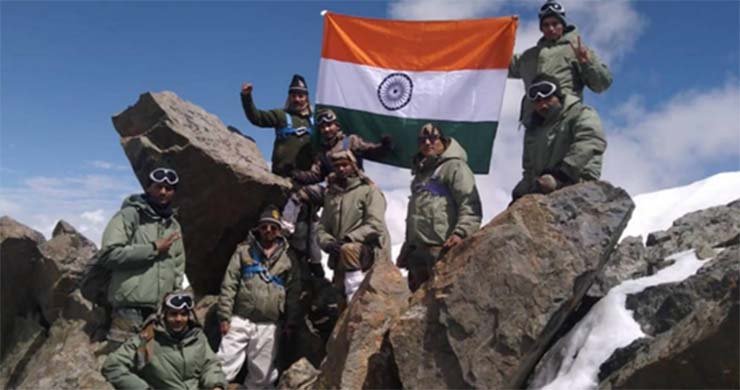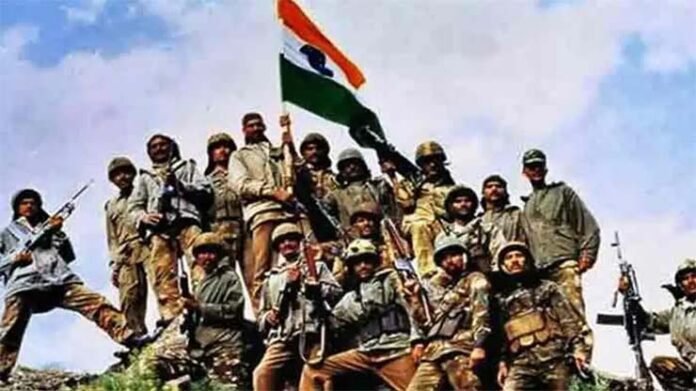The 25th Kargil Vijay Diwas anniversary, on July 26, commemorates India’s triumph in the Kargil conflict in 1999. This conflict marked the successful completion of ‘Operation Safed Sagar’ by the Indian Air Force (IAF) and ‘Operation Vijay’ by the Indian Army. It was a noteworthy achievement in military aviation’s history since it was the first-time air power was effectively utilised to attack targets at extremely high altitudes.
In May 1999, Pakistani forces breached the Line of Control (LOC) and made substantial progress in the Mushkoh, Dras, Kaksar, and Batalik sectors. The extent of infiltration across the LOC varied between 4 and 8 km in each region. Enemy forces were concealed at many crucial locations, rendering artillery and air power ineffective in compelling their withdrawal. The Indian Army encountered the intricate task of strategically positioning soldiers for direct assaults, which consumed considerable time and had a huge impact.
In light of the numerous and complex challenges that land forces encountered, on May 25, 1999, the Cabinet Committee on Security (CCS) granted permission to the IAF to carry out operations against the infiltrators while ensuring that they do not breach the LOC. The Indian Air Force initiated Operation Safed Sagar on May 26, 1999
Air Operations: How the IAF Turned the Tide in Kargil Operations
The IAF’s actions in Operation Safed Sagar demonstrated the IAF’s strategic brilliance and capability to overcome severe challenges presented by the steep inclines and high altitudes exceeding 16,000 ft. These conditions created distinctive operational obstacles while engaging the enemy. The primary issue with operations was the difficulty in effectively targeting the adversary due to conducting operations at high altitudes. The rapid technological advancements and just-in-time training proved to be highly advantageous for the IAF in effectively utilising the air power to secure victory in this conflict, which took place at the highest battlefield in the World.
Decision-makers harboured concerns regarding the potential for the conflict to escalate into a full-scale war. Nevertheless, on May 11, 1999, the IAF received its initial request for air support employing Heptrs only. This request came as the Pakistan army’s infantry forces, disguised as terrorists and invaders, seized control of the elevated positions in Kargil. On May 21, 1999, the Air Force deployed its inaugural Canberra aircraft on a reconnaissance mission in the Batalik sector. The images depicted heavily defended bunkers and a significant presence of invaders armed with high-calibre weapons.
Subsequently, in light of the numerous and complex challenges that land forces encounter, on May 25, 1999, the Cabinet Committee on Security (CCS) granted permission to the IAF to carry out operations against the infiltrators while ensuring that they do not breach the LOC. The Indian Air Force initiated Operation Safed Sagar on May 26, 1999.
The effective utilisation of air power, without a doubt, prevented additional losses and significantly shortened the period during which our Army made significant advancements on the ground
Air operations weakened the enemy’s capacity to maintain a required level of morale and readiness. The crucial IAF airstrikes that significantly changed the trajectory of the battle were:
- On June 7, 1999, the IAF strategically deployed its trump card by executing air strikes using Mirage fighter jets on Pt 5140.
- On June 13, 1999, an airstrike was conducted against the Tololing Ridge Complex in the Batalik Sector.
- On June 16, 1999, a Mirage 2000 aircraft carried out a mission in the Batalik sector, targeting the snow-covered Muntho Dalo area. During this operation, bombs weighing 250 kilogrammes each were dropped by the IAF on the vital administrative and logistical camp located there. These assaults led to the effective destruction of the adversary’s logistical network. Over 300 Pakistani casualties were documented. Seventy tents and their associated goods were completely destroyed, significantly weakening the opposing forces’ morale and determination.
- The logistics camp at Point 4388 near Mushkoh was destroyed on June 23, 1999, by air strikes.
- On June 24, 1999, a significant example of air power deployment during the Kargil War was the airstrike on Tiger Hill. The IAF executed a targeted attack on the Pakistani positions by deploying Mirage 2000 fighter planes to deliver laser-guided bombs with utmost precision. The Pakistani infiltrators were compelled to relinquish their posts at the summit. 37 Pakistanis lost their lives, and nine tentages were demolished.
- The persistent strategic bombings conducted by the IAF caused uncertainty and disruption all around to the Pakistani forces. On July 26, 1999, the battle came to a formal end when India claimed triumph, having effectively recaptured all the territory that Pakistani infiltrators had seized.
The effective utilisation of air power, without a doubt, prevented additional losses and significantly shortened the period during which our Army made much significant advancements on the ground. Understanding the Kargil battle is essential to comprehend India’s evolving aerospace power alignment, as it provides an excellent case study of the employment of airpower in combined conflicts in high mountainous terrain.
Understanding the Kargil battle is essential to comprehend India’s evolving aerospace power alignment, as it provides an excellent case study of the employment of airpower in combined conflicts in high mountainous terrain
The IAF conducted a comprehensive range of operations, including around 5,000 offensive operations, 350 missions for reconnaissance and electronic intelligence (ELINT), and over 800 flights for escort missions. The IAF conducted nearly 2,000 helicopter sorties for casualty evacuations and air transport missions, demonstrating its readiness and capability.

Lessons Learnt
Kargil was a conflict that underscored the need for a robust and responsive defence strategy. In an event to mark 25 years of Kargil Vijay Diwas, Chief of Defence Staff General Anil Chauhan said, “The Kargil conflict highlighted the significance of maintaining vigilance and preparedness for safeguarding our borders. It also emphasised the importance of public and international diplomacy, a strategy used effectively to maintain the neutrality of inimical nations and gain global support.”
The Kargil Review Committee (KRC), ordered by the Goverment of India for the post-war analysis, highlighted several limitations pertaining to airpower operations during the Kargil War. Adverse weather conditions, such as thick fog, overcast skies, and gusty winds, impeded air operations. Aircraft and crew faced significant high-altitude challenges while operating at extreme heights. The transportation of fuel (Petrol, Oil and lubricants), ammunition, and spare parts to forward locations posed a considerable logistical challenge. The IAF’s capabilities in air defence, communications, intelligence, surveillance, and reconnaissance (ISR) were severely lacking besides their ability to counter the prevailing challenges effectively.
Adequate measures for modernising the IAF are in progress. The IAF has inducted state-of-the-art fighter aircraft such as the Rafale, Tejas Mk1A, and MI-17 V to replace its obsolete fleet of MiG series fighters, thereby upgrading its aircraft fleet. Su-30MKI, Mirage 2000, and Jaguar squadrons are also undergoing modernisation processes. Aatmanirbharta projects are also in progress
In view of these challenges, adequate measures for modernising the IAF are in progress. The IAF has inducted state-of-the-art fighter aircraft such as the Rafale, Tejas Mk1A, and MI-17 V to replace its obsolete fleet of MiG series fighters, thereby upgrading its aircraft fleet. Su-30MKI, Mirage 2000, and Jaguar squadrons are also undergoing modernisation processes. Aatmanirbharta projects are also in progress.
The ISR and airborne detection capabilities have been improved for efficient and prompt decision-making. Network-centric operations (NCO) capability with software-defined radio and encrypted communication has been enhanced. These resources will enable better situational awareness, enhance interoperability, improve real-time information sharing, and strengthen joint operations and coordination.
As part of logistics and maintenance upgrades, necessary improvements have been made to the logistics supply chain to ensure that all support and maintenance infrastructure is easily accessible in any terrain.
Way Ahead
Despite the progress made by the IAF, the shortage of fighter squadrons, AWACS, AEW&C, and air-to-air refuellers still needs adequate attention. The time it takes to complete modernisation programmes merits close watch. Additionally, the Indian Government has taken initiatives to create a defence production sector ecosystem that will improve the IAF inventory and make it more robust.
The writer is a Senior Fellow at the Centre for Air Power Studies. Prior to this he was Group Captain in the IAF. He served the IAF for more than three decades in various capacities. He was Director Air Staff Inspections and retired as Director, Joint Control and Analysis Centre. The views expressed are personal and do not necessarily reflect the views of Raksha Anirveda
-The writer is a Senior Fellow at the Centre for Air Power Studies. Prior to this he was Group Captain in the IAF. He served the IAF for more than three decades in various capacities. He was Director Air Staff Inspections and retired as Director, Joint Control and Analysis Centre. The views expressed are personal and do not necessarily reflect the views of Raksha Anirveda






